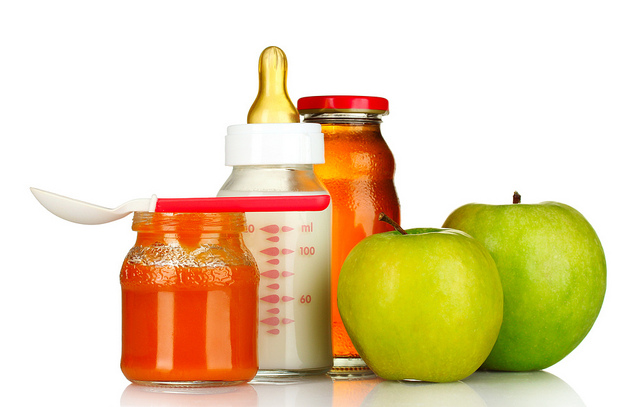The process of gradually replacing breast milk with other foods is called weaning.
According to health experts babies should be exclusively breast fed for 6 months. After 6 months, breast milk alone is not sufficient to provide the required nutrients. Hence other foods need to be introduced.
It is natural for you to feel nervous about how you are going to wean your baby. Armed with these basic guidelines and some creativity from your side, weaning can be a fun process for both you and your baby.
Tips to Introduce Food
New Food:
Start with only one food item at a time and give her only that for at least a week. This will help you to know how your child’s body is reacting each new item. Keep a watch for symptoms like colicky crying, skin rashes, itchy eyes or diaper rash. If you see any of this then it is best to stop this new food for a few months.
Portions:
When you introduce a new food in your baby’s diet then begin with only a small portion. A small portion means 1 to 2 teaspoons. This can gradually be increased to half and a cup.
Consistency:
You child has been drinking only milk till now. So she won’t know how to chew on solid food. So the best food consistencies to begin with are liquids or watery purees. Gradually the thickness can be increased when you can introduce well-mashed food to her.
Flavours:
Don’t hide the natural flavours of the foods by adding salt or sugar. For example if it is apple puree then let her have it without adding sugar. If you are feeding her pulses, while a tiny pinch of spices like coriander and turmeric can be added, leave the salt.
This will help her to begin grasping how different food taste different. It will also help you to understand what kinds of flavours are appealing to her taste buds.
Breastfeeding:
Don’t stop breastfeeding completely all of a sudden. Instead start by replacing one breastfeed or formula feed with a weaning food. Gradually increase the frequency of these foods so that by 9 to 10 months of age, your baby has 3 to 4 meals per day instead of 3 to 4 feeds of breast milk or formula.
We have more weaning tips and tricks for you here: 10 Tips to Transition from Breast to Bottle or Cup
Precautions
There are some precautions that you should take when it comes to giving your baby outside food.
- Handle the baby’s food only after washing your hands well with soap and water.
- Make sure that all cooking and serving utensils have been sterilized using boiled or filtered water.
- Serve only fresh food to your child.
- Keep the prepared food well covered all the time.
- Always check the temperature of the food before giving it to your child. No food should be very hot or very cold.
- While traveling, always carry baby’s food and water in food grade boxes.
Types of Food to be Introduced
First Foods: 6 to 7 months:
These foods should ideally be liquids or finely mashed or pureed solids.
Some food options for this age group is as given below.
- Puréed fruits like cooked apple and pear
- Mashed banana, mango, papaya
- Puréed or well-mashed cooked vegetables, such as potato and carrot
- Soft khichdi made from rice and moong dal
- Pressure-cooked and mashed thick dal
- Rice mixed with your baby’s milk
You will find that soon your baby is able to chew soft and lumpy food even though she doesn’t have teeth. That is when you can try these.
- Cook the meat well and then blend it.
- Well cooked and mashed fish served in small lumps
- Vegetable purées of peas and spinach served with mashed rice
Find out what other mothers are feeding their babies during the weaning process: Weaning Using 100% Natural Food
Second Foods: 7 to 9 months:
This is the time when you should switch from pureed foods to those that have been mashed or minced. Starting different food textures from an earlier age is better. If you wait till they are more than 10 months of age to introduce variety into their diet, there are chances that it will be rejected.
This is the age when starchy and protein rich food in your baby’s diet is ideal. Just keep in mind that they wont be able to eat too much of anything. Hence a little bit of both should be served to them.
Starch
- Various breakfast cereals
- Mashed potatoes
- Pieces of bread
- Pasta
- Rice in the form of khichdi or mashed with daal
- Idli
- Dalia
- Oats
- Raagi or semolina porridge
Protein
- Fish
- Eggs that have been cooked well
- Chicken and Meat
- Pulses
At this age she might show interest in holding the food herself and eating. Do encourage that and serve her finger food. For example, you could try slivers of boiled carrot, pieces of cheese or slices of banana.
Although your baby is still having her milk, you can begin giving her other drinks too. For example, you could give her a little boiled water in a small glass or some diluted fruit juice (without adding sugar to it). If the doctor allows cow’s milk then you can even give her milk shakes and fruit smoothies.
Third Foods: 10 months onwards
For children who are in this age group the food can be served in small bite sized pieces.
Your baby’s meals will be more adult-like now because they will be eating two to three meals a day together with a couple of snacks.
Most of the family food can be served keeping the spice levels to a minimum. For example; rice, dal, rotis, parathas, vegetables, dosa etc.
Finger foods like carrot sticks or cucumber pieces can be fed to the baby under supervision.
Non-vegetarian options include egg yolk, chicken, fish and meat. Egg whites should be preferably given after one year.
If your baby is breastfed you can continue feeding her. However, you will notice that she doesn’t want to feed as often now. If you are formula feeding then you can drop one or two formulas a day. But carry on giving her breast / formula milk till she is at least a year old.
Find out what is the best time to begin weaning your baby: The Best Time to Wean your Baby
Avoidable Foods
Till your baby is a year old there are some foods that you should avoid giving her.
- Salt: Your baby’s kidneys are not mature enough to cope with salt. So avoid adding it to her meals. Also avoid serving her any pre-packaged or canned food because they contain a high level of salt in them.
- Honey: Often honey contains a type of bacteria that can have adverse effect on our baby’s intestines.
- Sugar: Excess of sugar can harm the baby’s teeth
- Foods like whole nuts and green peas because they can be a choking hazard. Nuts like peanuts can also cause food allergies and so is best avoided.
- Some types of fish that are high on mercury content like the mackerel
- Food like soft cheese and undercooked eggs because they can cause food poisoning
- Grains that contain gluten like wheat, rye and barley
- Citrus fruits
- Cow’s Milk
- Soya
- Egg
Food Allergies
If allergies run in your family then it is best to consult your pediatrician before introducing any new food in your baby’ diet.
Also be very slow to introduce new foods. Give very small amounts of a new food and also give only one at a time and wait to see how your baby reacts to it. If you notice that she is developing any skin rashes then it will be best to isolate such foods.
Foods that should be ideally introduced one at a time are:
- Grains that contain gluten like wheat, rye and barley
- Citrus fruits
- Cow’s Milk
- Soya
- Egg






